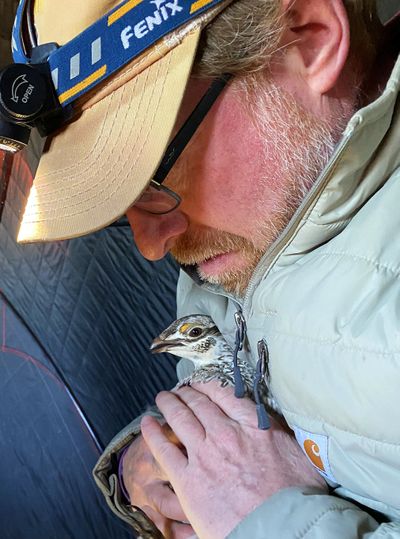Sharptail grouse study in north-central Montana proving value of drones

BILLINGS – Finding a sharp-tailed grouse on its nest is no easy task, even when the hens are collared with tracking devices.
Jason Hanlon found that out this spring as he attempted to locate 10 sharptail hens. They had been captured and collared in April for a study he is working on with Montana State University professor Lance McNew. Hanlon is also the Northern Great Plains Land Steward for The Nature Conservancy, headquartered at TNC’s Matador Ranch in north-central Montana where the birds were trapped.
The two men collaborated with representatives from Montana Fish, Wildlife & Parks, The Nature Conservancy and Pheasants Forever to trap sharp-tailed grouse when the birds gathered at their mating grounds, called leks. Of the 10 sharptails collared, Hanlon was able to locate nine birds using radio telemetry after they laid eggs and nested.
The 10th hen flew east and never stopped traveling, last recorded 7 miles away from its capture site.
Even with radio collars transmitting their location, Hanlon said it was difficult to triangulate the whereabouts of the well-camouflaged fowl. The chicken-sized birds are dappled with brown, black and buff colored feathers interlaced with white. Their legs are also feathered to keep them warm in winter.
Nested
Out of the nine collared grouse that remained nearby, eight successfully nested. The ninth nest couldn’t be found.
Once located, Hanlon had to visit the nests and scare the hens off to see how many eggs had been laid.
Some of the birds nested in unlikely places. One made its nest under a tiny yucca plant. Another was only 5 yards off the nearby highway.
“This is interesting, something I learned the hard way,” Hanlon said. “One hen laid its nest in poison ivy. I didn’t figure that out until afterward, but now I know where the poison ivy is.”
Except for the disappearing hen, all of the birds traveled west to nest. None went due north or south. Half of them crossed the highway on their trek.
“They all go off and do their own thing,” Hanlon said, despite gathering for the breeding season.
Hens
Sharptail mothers are loathe to leave their nests once the eggs are laid. It may take more than 20 days for the eggs to hatch, and the hens rarely leave the eggs untended. When they do leave, however, weird things can happen.
In one nest, Hanlon found eggs that looked different. A pheasant hen had laid four of its eggs in the sharptail’s nest, an act referred to as parasitism. That nest had 18 eggs in it. Most of the others averaged around 12 eggs. The eggs in six of the nests successfully hatched.
“Nest parasitism of prairie grouse nests by pheasants is not uncommon – it happens pretty much everywhere prairie-chickens and sharptails overlap pheasants,” McNew wrote in an email. “In fact, intraspecific nest parasitism (grouse dumping eggs in other grouse nests) also occurs, at least for prairie-chickens (I’d expect sharp-tailed grouse, too).”
Droning on
Once the successful nesting sites were located and it was confirmed they contained eggs, Hanlon shifted to the other portion of his study: identifying the nests by flying a drone overhead.
In total he flew 27 flights, varying the altitude from 100, to 150 to 200 feet to gauge the difference altitude might make in seeing the birds.
“One-hundred-fifty feet was the sweet spot,” he said.
McNew called the pilot study, to see if drones could be used to identify nesting sharptail hens, a success.
“Jason was able to identify nesting hens with a thermal-equipped UAV without disturbing the birds,” he said. “We, with our FWP partners, are planning to scale up and expand the approach to monitor nests and broods of translocated hens next year. I see great potential in this technology to collect demographic information from birds more efficiently and with less disturbance of the birds.”
Hanlon said the fact that FWP is getting involved, and experimenting with drone use for other projects, is an exciting part of his work – searching for a new tool other biologists may be able to adapt to their specific needs.
Ty Smucker, an FWP wildlife biologist, credited Hanlon with sparking the agency’s interest in using drones to help locate and monitor nesting grouse and broods in conjunction with FWP’s Western Montana Sharp-tailed Grouse Restoration effort in the Blackfoot, Bitterroot and Upper Clark Fork valleys.
“Preliminary flights to use a drone with an infrared camera to count the number of juvenile grouse in broods in August 2023, were successful, with little to no disturbance from the drone,” Smucker wrote in an email. “In 2024, we are planning to compare disturbance, survival, and nest success among grouse in the restoration areas, between ground-based and drone-based monitoring, to assess the application of this new technology to wildlife monitoring and restoration efforts.”
He added FWP is increasingly using drones for monitoring and managing many species of wildlife across Montana.
Hanlon said drone use is exciting since the machines are now relatively affordable.
“The first thing I’m interested in, when I see research, is how much it costs,” he said.
“Anybody can do cool stuff with $3 million.”